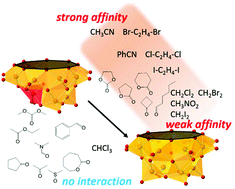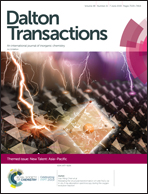Evaluation of the chemo- and shape-selective association of a bowl-type dodecavanadate cage with an electron-rich group†
Abstract
The host–guest interaction between a half spherical-type dodecavanadate (V12) and a neutral molecule guest was evaluated by monitoring the flip of a VO5 unit caused by the presence or absence of a guest in the cavity of V12. In N,N-dimethylformamide (DMF), V12 adopted the guest-free form (V12-free). By the addition of several guest molecules, such as acetonitrile, nitromethane, and dichloromethane, the structural conversion to the guest-inserted form (V12(guest)) was observed with the affinity constants of 137 ± 10 M−1, 0.14 ± 0.1 M−1, and 0.15 ± 0.1 M−1, respectively. In the case of 1,2-dichloroethane, 1,2-dibromoethane, and 1,2-diiodoethane, the constants were 35 ± 5 M−1, 114 ± 5 M−1, and 2.1 ± 0.5 M−1, respectively, suggesting that the bromo group is the best fit to the cavity of the bowl. A cyclic carbonate, 5- and 6-membered lactones, cyclobutanone, and hexanal were inserted into the V12 host, while a non-cyclic carbonate, non-cyclic and 7-membered cyclic ester, a ketone with a 5-membered ring, and benzaldehyde showed no effect on the guest insertion. The V12 host preferred to hold a guest with an electron-rich group, and the bowl-type structure showed the unique shape-selective interaction with the guest.

- This article is part of the themed collection: New Talent: Asia-Pacific


 Please wait while we load your content...
Please wait while we load your content...
